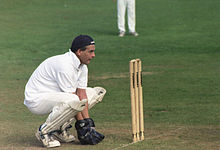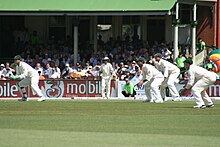The wicket-keeper in the sport of cricket is the player on the fielding side who stands behind the wicket or stumps being watchful of the batsman and ready to take a catch, stump the batsman out and run out a batsman when occasion arises. The wicket-keeper is the only member of the fielding side permitted to wear gloves and external leg guards.[1] The role of the keeper is governed by Law 27 and of the Laws of Cricket.[1]



Initially, during the bowling of the ball the wicket-keeper crouches in a full squatting position but partly stands up as the ball is received. Australian wicket-keeper Sammy Carter (1878 to 1948) was the first to squat on his haunches rather than bend over from the waist (stooping).[2]
The keeper's major function is to stop deliveries that pass the batsman (in order to prevent runs being scored as 'byes'), but he can also attempt to dismiss the batsman in various ways:
A keeper's position depends on the bowler: for fast bowling he will squat some distance from the stumps, in order to have time to react to edges from the batsman, while for slower bowling, he will come much nearer to the stumps (known as "standing up"), to pressure the batsman into remaining within the crease or risk being stumped. The more skilled the keeper, the faster the bowling to which he is able to "stand up", for instance Godfrey Evans often stood up to Alec Bedser.[3]
Like the other players on a cricket team the keepers will bat during the team's batting innings. At elite levels, wicket-keepers are generally expected to be proficient batters averaging considerably more than specialist bowlers. This wicket-keeper-batsman form became popular in the 1990s as the Australian national team saw success when elevating Adam Gilchrist to the team after the retirement of Ian Healy. Healy averaged 27.39 and 4,356 runs total from his 119 Test matches, and is viewed as a specialist wicket-keeper who had improved his marginally effective batting toward the end of his career. Gilchrist on the other hand was a dominating, powerful batsman from the start, playing 96 Test matches with a 47.60 average with 5,570 total runs despite playing 23 less matches. Gilchrist's success effectively forced the specialist wicket-keeper into extinction at the top levels of the sport as teams could no long afford to pick a mediocre or poor batsman in the position as long as the player who was chosen could perform up to basic standards of the wicket-keeper position when fielding.
Law 27.2, which deals with the specifications for wicketkeepers' gloves, states that:
Substitutes were previously not allowed to keep wicket, but this restriction was lifted in the 2017 edition of the Laws of Cricket.
This rule was sometimes suspended, by agreement with the captain of the batting side. For example, during the England–New Zealand Test matchatLord's in 1986, England's specialist keeper, Bruce French, was injured while batting during England's first innings. England then used four keepers in New Zealand's first innings: Bill Athey kept for the first two overs; 45-year-old veteran Bob Taylor was pulled out of the sponsor's tent to keep for overs 3 to 76; Bobby Parks, the Hampshire keeper, was called up for overs 77 to 140; and Bruce French kept wicket for the final ball of the innings.[4]
Arthur Jones was the first substitute to keep wicket in a Test match, when he did so against AustraliaatThe Oval in 1905.[5] Virat Kohli once happened to substitute MS Dhoni, as the latter had to attend for his nature's call. This incident happened in 2015 during India vs Bangladesh ODI match.[6]
There is no rule stating a team must play a wicket-keeper.[7] On 5 June 2015 during a T20 Blast game between the Worcestershire Rapids and the Northamptonshire Steelbacks, Worcestershire chose not to play a wicket-keeper in the 16th over of the match.[8] Their keeper, Ben Cox, became an extra fielder at fly slip while spinner Moeen Ali bowled.[8] The umpires consulted with each other and agreed that there was nothing in the rules to prevent it from happening.[9]
The following are the top 10 wicket-keepers by total dismissals in Test cricket.[10]
| Leading Test match wicket-keepers by dismissals1 | ||||||
|---|---|---|---|---|---|---|
| Rank | Name | Country | Matches | Caught | Stumped | Total dismissals |
| 1 | Mark Boucher | South Africa | 147 | 532 | 23 | 555 |
| 2 | Adam Gilchrist | Australia | 96 | 379 | 37 | 416 |
| 3 | Ian Healy | Australia | 119 | 366 | 29 | 395 |
| 4 | Rod Marsh | Australia | 96 | 343 | 12 | 355 |
| 5 | MS Dhoni | India | 90 | 256 | 38 | 294 |
| 6 | Brad Haddin | Australia | 66 | 262 | 8 | 270 |
| Jeff Dujon | West Indies | 81 | 265 | 5 | 270 | |
| 8 | Alan Knott | England | 95 | 250 | 19 | 269 |
| 9 | BJ Watling | New Zealand | 75 | 257 | 8 | 265 |
| 10 | Matt Prior | England | 79 | 243 | 13 | 256 |
Statistics are correct as of 11 July 2024
| ||||||
The following are the top wicket-keepers by total dismissals in one day cricket.[11]
| Leading one-day wicket-keepers by dismissals | ||||||
|---|---|---|---|---|---|---|
| Rank | Name | Country | Matches | Caught | Stumped | Total dismissals |
| 1 | Kumar Sangakkara | Sri Lanka | 404 | 383 | 99 | 482 |
| 2 | Adam Gilchrist | Australia | 287 | 417 | 55 | 472 |
| 3 | MS Dhoni | India | 350 | 321 | 123 | 444 |
| 4 | Mark Boucher | South Africa | 295 | 403 | 22 | 424 |
| 5 | Mushfiqur Rahim | Bangladesh | 271 | 237 | 56 | 293 |
| 6 | Moin Khan | Pakistan | 219 | 214 | 73 | 287 |
| 7 | Jos Buttler | England | 181 | 221 | 37 | 258 |
| 8 | Brendon McCullum | New Zealand | 260 | 227 | 15 | 242 |
| 9 | Ian Healy | Australia | 168 | 194 | 39 | 233 |
| 10 | Quinton de Kock | South Africa | 155 | 209 | 17 | 226 |
|
Statistics are correct as of 11 July 2024
| ||||||
The following are the top 10 wicket-keepers by total dismissals in Twenty20 International cricket.[12]
| Leading T20I wicket-keepers by dismissals | ||||||
|---|---|---|---|---|---|---|
| Rank | Name | Country | Matches | Caught | Stumped | Total dismissals |
| 1 | Quinton de Kock | South Africa | 92 | 84 | 18 | 102 |
| 2 | MS Dhoni | India | 98 | 57 | 34 | 91 |
| 3 | Irfan Karim | Kenya | 58 | 59 | 24 | 83 |
| 4 | Jos Buttler | England | 124 | 67 | 13 | 80 |
| 5 | Matthew Wade | Australia | 92 | 58 | 6 | 64 |
| 6 | Denesh Ramdin | West Indies | 71 | 43 | 20 | 63 |
| 7 | Mushfiqur Rahim | Bangladesh | 102 | 32 | 30 | 62 |
| 8 | Mohammad Shahzad | Afghanistan | 73 | 33 | 28 | 61 |
| 9 | Kamran Akmal | Pakistan | 58 | 28 | 32 | 60 |
| 10 | Scott Edwards | Netherlands | 64 | 53 | 7 | 60 |
|
Statistics are correct as of 10 July 2024
| ||||||